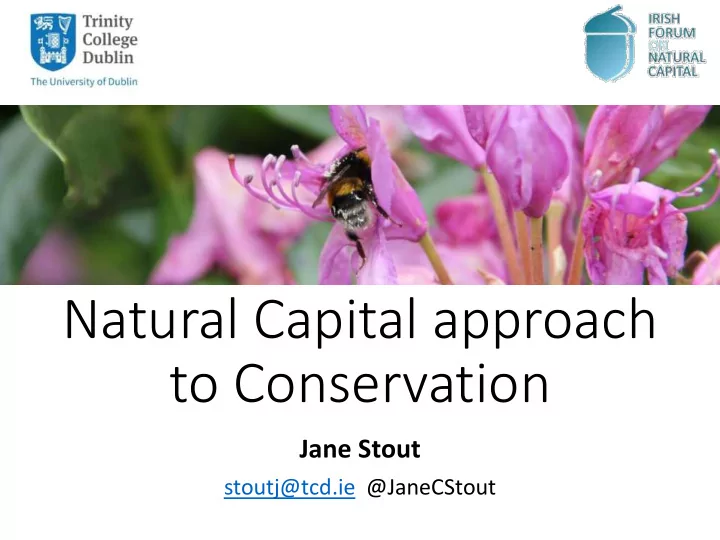

Natural Capital approach to Conservation Jane Stout stoutj@tcd.ie @JaneCStout
Ecosystem services concept Outputs from nature that have benefit and value to human wellbeing Provisioning Regulating Cultural : Goods produced or provided by Benefits obtained from regulation of Non material benefits obtained from ecosystems ecosystem processes ecosystems • Food • Climate regulation • Spiritual • Fresh water • Disease control • Recreational • Fuel/Fibre • Detoxification • Aesthetic • Biochemicals • Pollination • Inspirational • Genetic resources • Natural enemies • Educational • Communal • Symbolic Supporting Services necessary for the production of all other ecosystem services • Soil formation • Nutrient cycling • Primary production
Approaches to conservation… Pre 1970s 1980s-90s 2000-2005 2005-present Nature for itself Nature despite people Nature for people Nature and people Mace (2014) Science
Natural Capital Approach Linking the economy to nature… Ecosystem goods and services Natural Capital Economic Activity Natural resources: water, Production & consumption of minerals, soils, living goods & services ecosystems Impacts on Adapted from www.sustainableprosperity.ca
Linking ecosystem Biodiversity services and natural Variety of life: genetic, species, ecosystem capital: Cascade model Ecosystem processes and functioning (e.g. primary production, formation of biomass, decomposition and Nature/ Social/economic capital Ecosystem nutrient cycling) Wildlife services (e.g. harvestable products, waste regulation and Benefit well- remediation, climate being : health, Natural capital regulation, regulation of pests and diseases) security, production (e.g. provision of food, shelter and energy, air and water regulation, Value to maintenance of economies habitat, control of pests, aesthetic (e.g. value of beauty, recreation) products, willingness to pay for protection of woodland) Adapted from Haines-Young et al. 2012 report to EEA
Natural Capital Not the Natural resources: water, same as… minerals, soils, living ecosystems Natural Capital Approach To enable better decision-making, when decisions are based on economic arguments
Nature by numbers (IUCN-NL) https://vimeo.com/153076408
How do we value natural capital? Direct use value: consumptive (eg provisioning) non-consumptive (eg cultural) Indirect use value: regulating services (e.g. pollination, pest control, water regulation, soil fertility… ) Non use value: existence, bequest
Example: pollination
75% crop species are animal pollinated
Calculating contribution of f pollinators to crop production: Dependency - crop loss Cost of alternative in absence of pollinators methods 30% decline in seed weight = €4 million “value” yr -1
€ 53 million € 14.6 billion € 153 billion Gallai et al. 2009 Leonhardt et al. 2013 Bullock et al. 2008
Food security for 9bn people Rice zzwbz.com
Pollinator loss: Fruit Vegetables Nuts&seeds 0 Healthy diet fruit vegetables nuts and seeds Global supply -10 -20 Smith et al. 2015 -30 • 2.2 billion people Vitamin A intake Half of plant-derived sources of • 71 million people newly deficient vitamin A require pollination in Vitamin A • Diet changes global deaths by 1.42 million per yr Chaplin-Kramer et al. 2014
Consumer choice Luxury Products
Other direct use values www.tourismireland.com Fashion and art Tourism and leisure Industry gereports.ca
Other values? 87.5% flowering plants are animal pollinated
Pollination is a key function in maintaining diversity in terrestrial ecosystems…
Ecosystem value E.g. pollinator larvae control crop pests E.g. fruit and seeds for farmland animals & maintenance of plant communities
Value of pollination? Crop pollination: economic value, health value, consumer choice, food security Pollination of other plants of economic or cultural value (biofuels, medicinal, symbolic plants) Wild plant pollination: healthy ecosystems for wildlife, recreation, tourism, future generations
By recognising value, case is made to justify conservation… www.biodiversityireland.ie/pollinator-plan
1. Creating pollinator friendly habitats 2. Raising awareness 3. Supporting beekeepers & growers 4. Expanding knowledge www.biodiversityireland.ie/pollinator-plan 5. Tracking changes
Learn more about Natural Capital www.naturalcapitalireland.com SUMMARY • Natural capital approach about valuing nature to incorporate into decision-making • Economic and non-economic values • Can lead to conservation action e.g. AIPP stoutj@tcd.ie @JaneCStout Download the All-Ireland Pollinator Plan from www.biodiversityireland.ie/pollinator-plan
Recommend
More recommend